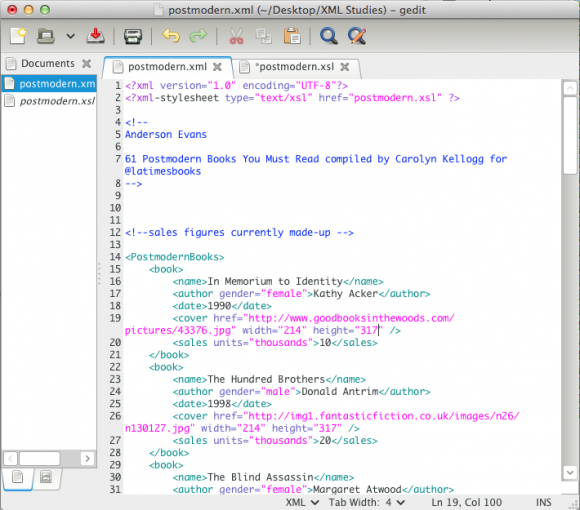I’ve been practicing with XML and XSLT stylesheets. Using this list from the LA Times I’ve been able to create a very basic data set complete with book covers. I believe this is a very good first step toward being able to create something engaging with a relevant data set. I’m not sold on this theme. I believe the difficulties inherent in trying to do textual analysis of postmodern prose with all of its experimental punctuation would prove more tiring than beneficial. It is certainly the kind of data set that is worthy of further investigation at some point, but not for me, not right now.
I’ve been watching the paradigm shifting House of Cards on Netflix, and there are several aspects of the show I find interesting and prescient. The series follows a high ranking US government politician acting as a fourth wall breaking antihero in a black comedy about government, a play on a trope that goes back at least as far as Robert Penn Warren’s All the King’s Men and perhaps even as far back as Shakespeare’s Richard III. How does dominating cultural literature and its audio-visual offspring inform us in regard to our cultural understanding of government and politics? We often analyze the 24 hour news cycle, but is there something perhaps even more telling in our more abstracted forms of mass expression? How “real” are our political figures in this country, and how much are they disembodied icons we can only understand in the capacity of encoded media communication? And while our metanarrative of around-the-clock “news” cycles pushes on, we often neglect the study of cinema’s commentary on political theater.
And I do think I should emphasize cinema here, because House of Cards walks the line between a 13 hour feature film and a television series in a way that is completely new and as the most watched show on Netflix, the series’ performance far exceeds what must have been expected. The success of this new embodiment of long form narrative insists that the medium has a message worth considering: this new rapidity of content delivery makes one question even more what is real and what is unreal. These are the pseudo-conclusions I have after initial close readings/viewings of material, and I believe a kind of digitally mediated distant reading supplemented with computational analysis and more in-depth close reading might bring certain trends to light, in both fictional worlds and the this other world that professes to be tangible.
NOTE:
The assigned text An Even Gentler Introduction to XML was helpful in my initial XML exploration
I was able to move into even more constructive territory after viewing this XML video tutorial:




